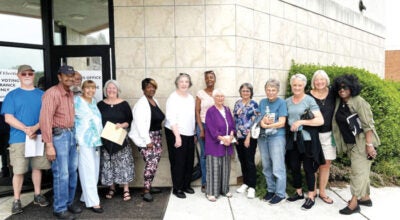‘Going to See the Elephant’ a fun romp
Published 12:00 am Thursday, March 5, 2009
By Deirdre Parker Smith
dp1@salisburypost.com
In these days when newspapers are going the way of the dodo bird, a book about a naive young man who turns a city on its ear through his journalism is poignantly funny.
For those of us left in the field, painfully funny may be closer to the truth.
And Rodes Fishburne, author of “Going to See the Elephant,” is having a ball.
His young writer, who only wants to be the best one in the world, ever, is delightfully clueless about the real world.
On the other hand, Fishburne’s world is far from real. Although he says he wrote the book to celebrate the city of San Francisco, it’s a city seen through rose-colored glasses after a few Cosmopolitans from a hill overlooking the best neighborhoods.
Its bad guys are so many comic book blowhards, funny in their inability to keep themselves from being exposed.
His newspapermen are from the good old days of smoky newsrooms, bottles in every desk, grumpy reporters in limp white shirts with crooked, food-stained ties.
Fishburne will be at Literary Bookpost Wednesday evening signing and talking about the book.
He has friends in Salisbury and can’t wait to visit. He loves the town and looks forward to Hap’s and a Cheerwine.
This is his first novel, but he has written for many magazines and newspapers, the New York Times, the New Yorker, San Francisco Chronicle, Oprah magazine. He’s written plays performed in New York, a lot of different things.
“I feel in the 21st century, a writer has to be a little different, has to do more than one kind of writing, more than one genre. … I try to write all the time.”
People ask him ó well, journalists do ó what he was thinking when he wrote a book about a newspaper reporter.
“I didn’t write it knowing about the timing of what was happening … the San Francisco Chronicle is going down, the Rocky Mountain News is gone. People are still interested in news, just not in the way they’re getting it now.
“I look at it like a forest fire. Yeah, it’s burning a lot of trees, but in six months, new shoots will come up.”
Fishburne has worked in a few newsrooms and figures they all attract the same kind of people. “I drew on my experience with that type of people” for the book.
“San Francisco has a rich newspaper history, colorful newspaper characters,” Fishburne says.
The newspaper he invents, the Morning Trumpet, “is not very prestigious, they don’t take themselves seriously. … People take themselves too seriously these days, newspapers, too.”
He had great fun with the Trumpet. “They will never have a Web site. They’re still cutting and pasting; they’re well apart from a more modern newspaper.”
Fishburne’s inspiration came one day when he was walking down a street in San Francisco in 2003. He passed a coffee shop and saw a guy writing in one of his journals, with 14 empty espresso cups around him.
“I took notes of him writing. I had a light bulb ó he’s come here to write, like Bret Harte and Jack London and the beat poets. … I’ve seen other examples of this type of person, people who come to write, and shortly, a name came into my head ó Slater Brown. The name helped it come together. I wanted the whole story to take place in the city; the city becomes a character in story and he’s come here to be a great writer and how would he accomplish that.”
Slater Brown is a naif, “He’s sort of that age where he’s romantic and has his head in clouds. He knows he can’t stay there forever. He’ll come out the other end of tunnel, more clear-eyed, more realistic. But maybe not hardboiled, not lose his wonder.”
Slater meets a girl in a park that he’s immediately besotted with. Turns out Callio de Quincy is one of the top chess players in the world, living nearly cloistered with her father.
He also meets a very eccentric, exceptionally brilliant scientist, Milo Magnet. (Fishburne has a way with names).
Slater’s fierce landlady, Mrs. Cagliostra, is, Fishburne says, like “a Benedictine monk waiting for the right novice to come along.”
The author’s charming style and characters have been a hit. “Going to See the Elephant” came out in January and already it has been chosen by Amazon.com as one of its seven best books. It was selected by Indie Booksellers for the January 2009 Indie Next List.
Don’t look for a message in the book. “I don’t like the idea of messages. For me it was getting all these characters in my head. It was a gift to me as a writer. They were managing me and I was trying to keep up with what they were saying, like I was along for the ride. That was part of the fun of it.”
He always has lots of ideas for characters and stories. “I recently found boxes of old notebooks from when I was 10 or 11 years old.” Shades of Slater Brown? “I put on the cover one word that would guarantee no one would open it: ‘Algebra’.”
So what’s the Salisbury connection? Fishburne’s wife, Lindy went to Camp Yonahlossee near Blowing Rock and became great friends with Meg Kluttz, now Dees, and they have remained friends ever since.
“Salisbury was right in the middle of the tour and a really good stop. … I can’t get wait to have some Cheerwine, Hap’s, maybe Krispy Kreme.”


